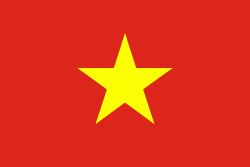Điện Biên Province (Tỉnh Ðiện Biên)
The name "Điện Biên" means "stable frontier" (referring to Điện Biên's location on the border between Lan Xang and Vietnam). Điện Biên has various ancient monuments including the caves Thẩm Khương, as well as Thẩn Búa in Tuần Giáo. The original settlers were the Ai Lao or Tai people who are a direct ancestor of Lao people in Laos today. The names of some villages and towns still use words of Tai origin, such as Mường (city) and Tham (cave).
In the 9th and 10th centuries, the Lự in Mường Thanh were the most developed in the area and controlled Sìn Hồ, Mường Lay, and Tuần Giáo.
In the 11th and 12th centuries, Tai people (not to be confused with the Thai people of Thailand) from Mường Ôm and Mường Ai occupied Mường Lò in Nghĩa Lộ and Mường Thanh in Điện Biên. They eventually gained control of the whole area between Mường Lò and Mường Thanh (Điện Biên).
Map - Điện Biên Province (Tỉnh Ðiện Biên)
Map
Country - Vietnam
 |
 |
| Flag of Vietnam | |
Vietnam was inhabited by the Paleolithic age, with states established in the first millennium BC on the Red River Delta in modern-day northern Vietnam. The Han dynasty annexed Northern and Central Vietnam under Chinese rule from 111 BC, until the first dynasty emerged in 939. Successive monarchical dynasties absorbed Chinese influences through Confucianism and Buddhism, and expanded southward to the Mekong Delta, conquering Champa. The Nguyễn—the last imperial dynasty—surrendered to France in 1883. Following the August Revolution, the nationalist Viet Minh under the leadership of communist revolutionary Ho Chi Minh proclaimed independence from France in 1945.
Currency / Language
| ISO | Currency | Symbol | Significant figures |
|---|---|---|---|
| VND | Vietnamese đồng | ₫ | 0 |
| ISO | Language |
|---|---|
| KM | Central Khmer language |
| ZH | Chinese language |
| EN | English language |
| FR | French language |
| VI | Vietnamese language |















